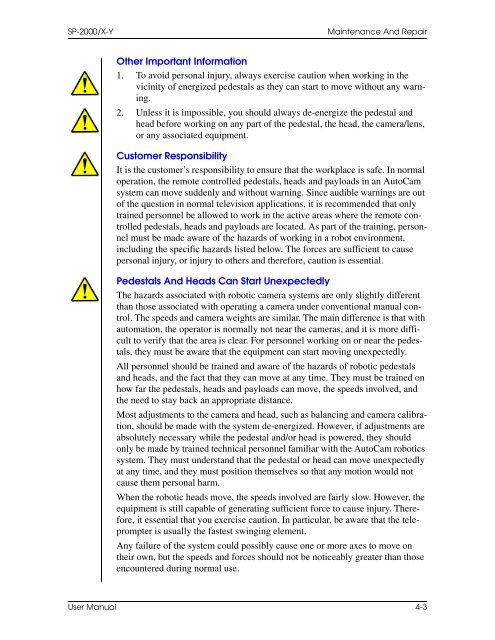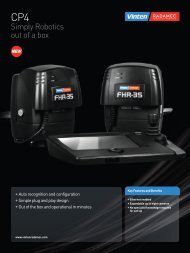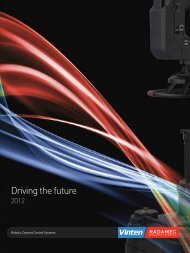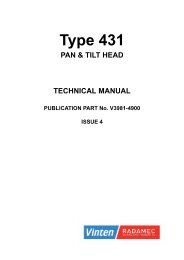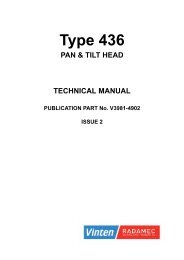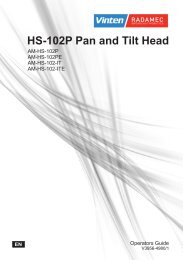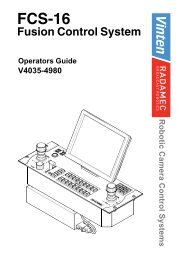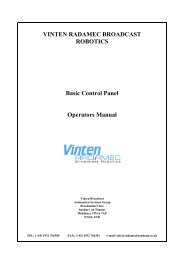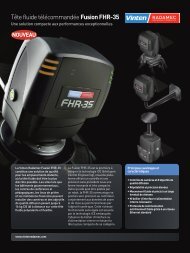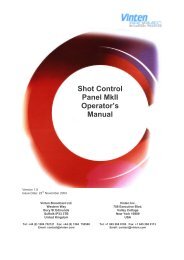SP-2000/X-Y AutoCam⢠Pedestal - Vinten Radamec
SP-2000/X-Y AutoCam⢠Pedestal - Vinten Radamec
SP-2000/X-Y AutoCam⢠Pedestal - Vinten Radamec
- No tags were found...
Create successful ePaper yourself
Turn your PDF publications into a flip-book with our unique Google optimized e-Paper software.
<strong>SP</strong>-<strong>2000</strong>/X-YMaintenance And RepairOther Important Information1. To avoid personal injury, always exercise caution when working in thevicinity of energized pedestals as they can start to move without any warning.2. Unless it is impossible, you should always de-energize the pedestal andhead before working on any part of the pedestal, the head, the camera/lens,or any associated equipment.Customer ResponsibilityIt is the customer’s responsibility to ensure that the workplace is safe. In normaloperation, the remote controlled pedestals, heads and payloads in an AutoCamsystem can move suddenly and without warning. Since audible warnings are outof the question in normal television applications, it is recommended that onlytrained personnel be allowed to work in the active areas where the remote controlledpedestals, heads and payloads are located. As part of the training, personnelmust be made aware of the hazards of working in a robot environment,including the specific hazards listed below. The forces are sufficient to causepersonal injury, or injury to others and therefore, caution is essential.<strong>Pedestal</strong>s And Heads Can Start UnexpectedlyThe hazards associated with robotic camera systems are only slightly differentthan those associated with operating a camera under conventional manual control.The speeds and camera weights are similar. The main difference is that withautomation, the operator is normally not near the cameras, and it is more difficultto verify that the area is clear. For personnel working on or near the pedestals,they must be aware that the equipment can start moving unexpectedly.All personnel should be trained and aware of the hazards of robotic pedestalsand heads, and the fact that they can move at any time. They must be trained onhow far the pedestals, heads and payloads can move, the speeds involved, andthe need to stay back an appropriate distance.Most adjustments to the camera and head, such as balancing and camera calibration,should be made with the system de-energized. However, if adjustments areabsolutely necessary while the pedestal and/or head is powered, they shouldonly be made by trained technical personnel familiar with the AutoCam roboticssystem. They must understand that the pedestal or head can move unexpectedlyat any time, and they must position themselves so that any motion would notcause them personal harm.When the robotic heads move, the speeds involved are fairly slow. However, theequipment is still capable of generating sufficient force to cause injury. Therefore,it essential that you exercise caution. In particular, be aware that the teleprompteris usually the fastest swinging element.Any failure of the system could possibly cause one or more axes to move ontheir own, but the speeds and forces should not be noticeably greater than thoseencountered during normal use.User Manual 4-3


